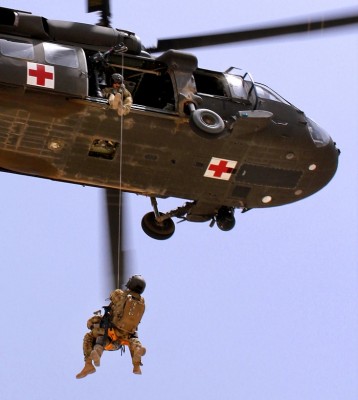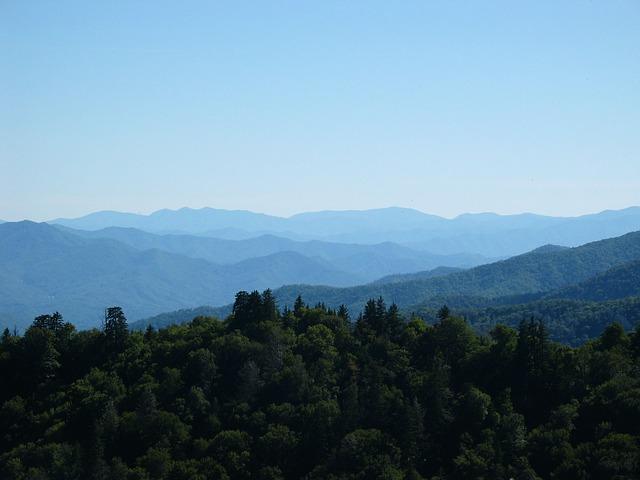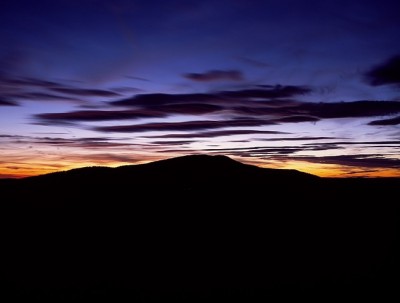I jerked up out of a fitful sleep to the sound of men shouting. My mind was still sticky as I tried to orient myself to the gray dawn after a night of trauma.
I was lying on the floor of an Appalachian Trail lean-to with three others—an older gentleman known as “The Old Ridgerunner” on one side of me, my husband Mark on the other, and a middle-aged man called Chris lying comatose beyond him.
Mark and I were out for a four-day trip through a slice of Maine’s famous “Hundred-Mile Wilderness,” so called due to limited road access. We were frequent hikers who spent most of our free time backpacking or bagging peaks in northern New England. We had embarked upon that trek from a trailhead along a gravel road some 16 miles north on Sunday afternoon, and by early evening Tuesday had arrived at a camping area nestled into a ravine on the northeast shoulder of White Cap Mountain.
The Logan Brook lean-to is pretty standard as trail sites along the Maine Appalachian Trail go. A three-sided log lean-to with a floor wide enough for five or six sleeping bags to lie comfortably side-by-side, a fire pit, a water source handy, a few tenting spots, and a privy discreetly tucked into the nearby forest at the end of a short side trail.
Nothing had seemed out of the ordinary when we arrived. We set about our usual campsite busyness—unpacking, filtering water from the brook, and setting up our tent in a spot about twenty feet from the lean-to.
Other hikers arrived and tended to similar activities. Ridgerunner and Chris both happened to be endeavoring to hike the entire Appalachian Trail in sections and were finishing up the last few hundred miles in Maine.
The Survival Water Filter That Fits In Your POCKET! [2]
Two other hikers, both young men, arrived for the night as well. One was a thru-hiker known as “Swami, “and the other was a weekend recreationalist named Greg, out for a four-day trek.
The group all chatted casually, getting to know one another on a cursory level as strangers who were thrown together for a night, each fading in and out of conversation as camp chores allowed.
We noticed a few odd things about Chris right from the start. He had been back on the trail just two days and a total of only 12 miles, and was surprisingly tired when he arrived at camp. As we prepared supper over our tiny portable stove near the lean-to, we noticed that Chris had already crawled into his sleeping bag. It was early in the evening for turning in, but hikers have their own way of doing things and we dismissed it.
Shortly thereafter, someone noticed that Chris’s feet were shaking, and asked him if he was all right. He responded coherently. He thought he would be okay, he said, but asked for water. I filled his water bottle with filtered water, and offered to make some soup for him. He rummaged through his belongings and produced a cup. I handed it back filled with soup, and he accepted it gratefully.
It was apparent to the other five of us present—Ridgerunner, Greg, Swami, Mark and me—that Chris was sick. We offered assistance, gave him water, and could do little else other than hope that sleep would heal him. As hikers, we’d all been there. For a sudden dehydration or flu or other malady that strikes a body while deep in the backcountry, the only cure is time and rest.
Darkness was encroaching when the seriousness of Chris’s condition became obvious. He suddenly vomited while lying on his back and began choking. My husband leapt into the lean-to and turned Chris onto his side. The choking subsided, but his breaths came in loud labored groans. Next, he began to convulse.
We were unable to rouse Chris, and realized in dismay that he had not been merely sleeping, but unconscious. His skin was hot and sweaty. We unzipped his sleeping bag and found that he was wearing several layers of clothing. It was a hot July evening, and we attempted to cool him by easing the sleeping bag away from his body and removing what clothing we could.
It was clear that our fellow hiker was in crisis, and this tiny group of people who had met for the first time only a few hours before was suddenly and completely in charge of the life of a person in our midst.
First, we did the obvious, tearing through all of Chris’s belongings in search of medical documents or prescription medication. Our search turned up no clues.
We discussed our options. None of us had cell phones. They were uncommon among serious hikers in those days, and reception from Logan Brook would have been unlikely anyway.
Chris was not going to walk out on his own, that much was clear. Someone was going to have to go get help. While we were weighing the risk of sending hikers out through the forest at night versus waiting for daylight, Chris suffered another round of choking and convulsing. That clinched it. We couldn’t wait.
Greg and Swami knew they had to be the ones to go. Despite the many miles of harsh mountainous terrain they had already hiked that day, their youth and strength made them the best choice.
We had to figure out the safest and fastest way for them to get help, and didn’t have much information to go on. Our only maps were those printed specifically for hikers and included just a narrow swath along the Appalachian Trail itself, and a rough large-scale road map of Maine that showed almost no unpaved roads.
We were in an area of Maine so remote that it didn’t even have a name—TB R11 WELS was its only nomenclature. The region is dotted with sporting camps, logging operations, and old grown-in roads, but we had no way of knowing where any of those might be in proximity to our location. Mark thought we might have crossed an old camp road a few miles back, but he couldn’t remember for sure, and didn’t know whether the camp road might dwindle to an unnavigable labyrinth, especially at night.
The best bet was to send Greg and Swami out along a known route to a public campground. Hay Brook Campground was in the wilderness, but it was accessible by car. The young men hoped to find a camper there.
Get Out Of The Rat-Race And Make Money Off-Grid! [4]
To that end, they would ascend the steep climb to the summit of White Cap Mountain and take a side trail from there down to Hay Brook. A total of eight miles, all in the black of night, after a full day of strenuous backpacking already under their belts.
We packed them up with extra headlamps, emergency gear and a prayer, and settled in to wait. I was scared. We all were, drifting in and out of sleep as we lay on the hard wooden lean-to floor next to the man whose condition seemed to be deteriorating.
None of us had dared to hope that help would arrive before late morning, and were surprised to hear an approaching game warden and paramedic shouting “Hello!” at daybreak Wednesday.
There had been access on the old camp road, it turned out. A camper at Hay Brook had called out to the gatehouse on a cell phone, and although reception had been spotty, the gatekeeper had got the gist of things and called the warden service. Equipped with maps and high-powered night travel equipment, they had reached Logan Brook from the camp road in just a few hours.
It was a relief to have professionals show up and take charge. The paramedic fired questions at us while he unpacked supplies and hooked up equipment to care for his patient.
The game warden set about brisk preparations for a helicopter evacuation. We were incredulous. How could that be, I asked him, here in a thickly forested ravine? They would lower a cable, he told me.
The rescue professionals used two-way radios to communicate with the warden service airplane circling overhead and a National Guard Blackhawk helicopter en route to the scene.
Meanwhile, we on the ground scrambled to prepare. The game warden chopped a few trees to widen the clearing. Ridgerunner, Mark, and I scurried to do as he directed, searching for materials to build a smudge fire in order to help the helicopter locate the site. I volunteered my blaze orange rain poncho to provide a target for the drop, and we used heavy rocks to hold it down. There was no time to dismantle tents and put away belongings, but we hurriedly grabbed everything up and tossed it off to one side of the lean-to.
The smoke had barely cleared the treetops than we heard the tut-tut-tut of the chopper. Hovering close to the trees over the tiny clearing, it lowered a Guardsman on a cable. Next came a long metal basket-like stretcher.
The noise and wind were incredible. The game warden had warned us that it would be like a hurricane, but I was still not prepared for such force. Small trees nearby were nearly flattened. We huddled in the back of the lean-to and covered our faces to protect them from the bits of flying gravel and sparks from the fire. My heart sunk as I watched my entire tent fly across the clearing and get sucked through the trees beyond.
 [5]The helicopter swooped away. The Guardsman and paramedic worked together to prepare Chris for transport. In the interim, we three campers rushed around the site trying to retrieve belongs and cover the embers in the fire pit.
[5]The helicopter swooped away. The Guardsman and paramedic worked together to prepare Chris for transport. In the interim, we three campers rushed around the site trying to retrieve belongs and cover the embers in the fire pit.
The helicopter returned and hovered overhead for several minutes while preparations were completed.
The paramedic went up first. It appeared to be his first live experience airlifting, so the Guardsman gave him some quick do’s and don’ts before he lifted off.
Chris went next. Two more rescuers had arrived on foot. They helped strap the still-unconscious patient to the basket, and we all watched in awe as the cable drew him up into the helicopter.
Rather than send the harness back down for the Guardsman to use—probably in the interest of time—the helicopter lowered an apparatus that looked like a large two-pronged pulp hook. The Guardsman straddled the hook and held on as he ascended skyward. We civilians on the ground below held our breaths and watched as the wind dragged him through the top branches of a nearby tall tree before reaching the open chopper door.
New Solar Oven Is So Fast It’s Been Dubbed “Mother Nature’s Microwave” [6]
Only about an hour had elapsed, from the time the first two rescue workers arrived to the moment the helicopter roared away. We hikers sat on the lean-to bench in a daze. Gear was strewn over a half acre of forest. Trees were laying over at a 45-degree angle.
We all did our best to sort gear, and the ground crew left on foot with what we hoped belonged to Chris.
Mark fired up a camp stove. The three of us relived the events of the past 12 hours over cups of coffee. We lauded the professionalism of the rescue crew—the skill of the helicopter pilot hovering in a mountain ravine at dawn, the expertise of the warden service, and the bravery and strength of the night hikers.
Ridgerunner packed his belongings and headed out. The two of us waited with Greg’s and Swami’s packs until their return around noon. We all exchanged stories again before parting ways—the three lone hikers northbound towards Katahdin, and Mark and I southbound toward our car waiting at a trailhead.
We managed to retrieve our tent from the puckerbrush. By some miracle we were able to bend the poles back enough that we could set it up and sleep in it the next night.
Back home two days later, I made some follow-up calls. The rescue professionals confirmed that our little group had made the right choices—sending hikers out in the night, and sticking with the route that involved more mileage but less risk.
Chris lived. He had an underlying physical disorder of which he was unaware, and had been exacerbated by trail conditions. As far as I know, he made a full recovery, and I hope he was able to finish the Appalachian Trail.
My husband and I went on to travel hundreds more hours and miles on trails throughout Maine and beyond, but never before or since has a four-day trek been so eventful. And for that, we are truly grateful.
Learn How To ‘Live Off The Land’ With Just Your Gun. Read More Here. [7]

